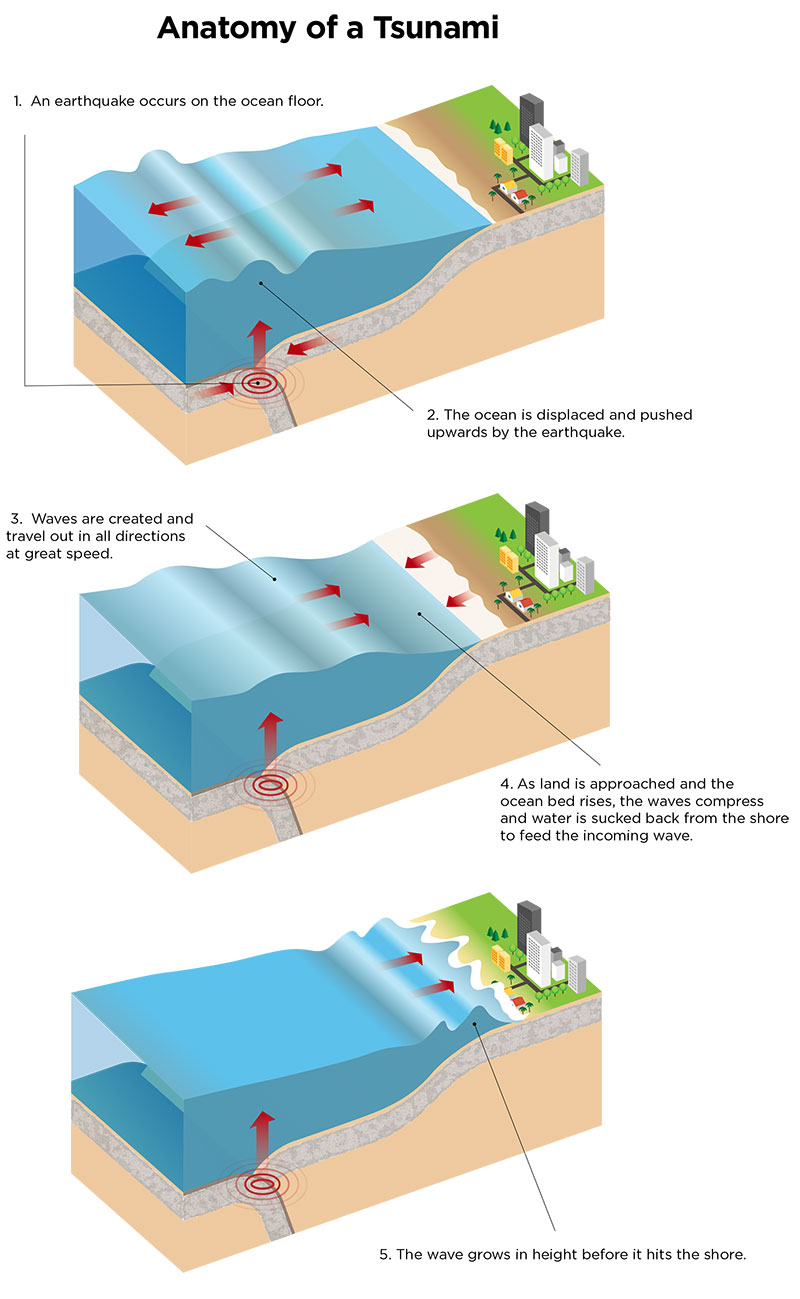Tsunami
Tsunami is a Japanese word: ‘tsu’ meaning harbour and ‘nami’ meaning wave.
Normal ocean waves are created by the wind and involve only the top few metres of the ocean.
A tsunami is a series of extremely long waves that involve the whole depth of the ocean. As a result, each wave contains a large amount of energy and a much greater destructive force.
According to the Global Historical Tsunami Database, since 1900, over 80% of tsunamis were generated by underwater earthquakes.
The Tsunami Process
A tsunami has four main stages:
Generation
The ocean is disturbed by a large and sudden displacement of water, most commonly an earthquake.
Propagation
Energy from the quake creates waves in ever-widening circles at speeds as fast as 800kph. At this stage, the tsunami wavelength, the distance from crest to crest, may be hundreds of kilometres. Mariners at sea in deep water will not normally notice a tsunami as the top of the wave at this stage rarely reaches more than one metre higher than the ocean swell.
Amplification
As the waves near the coast, the sea becomes shallower. This causes the height of the waves to increase and the wavelength to shorten. The waves are now larger, and closer together. The wave speed has now slowed to 30-50 kph. The sea recedes as the water is drawn back from the shoreline to feed the incoming wave.
Inundation (Run-up)
The tsunami hits shore. Run-up is the term used to describe how far the tsunami surges in land. Most tsunamis are less than 3 metres high, but in extreme cases, they can exceed 30 metres in height near their source. A tsunami may come onshore like a fast-rising flood or a wall of turbulent water, and a large tsunami can flood low-lying coastal areas several kilometres inland. Tsunami generally present as a series of waves with periods ranging from minutes to hours.

Ground Effects
Rushing water from waves, floods, and rivers is incredibly powerful. Just 15cms of fast-moving water can knock adults off their feet, and 30cms can carry away a small car. Tsunamis can be particularly destructive because of their speed and volume. They are also dangerous as they return to the sea, carrying debris and people with them.
Impacts on the built environment
Large tsunamis are significant threats to human health, property, infrastructure, resources, and economies. Tsunamis typically cause the most severe damage and casualties near their source, where there is little time for warning, but large tsunamis can also reach distant shorelines, and cause widespread damage. Effects can be long-lasting, and felt far beyond the coastline.
What does this mean for the Bay of Plenty region?
Studies commissioned by Bay of Plenty Regional Council assess the tsunami inundation hazard for the Bay of Plenty shoreline. These studies focus on tsunami resulting from earthquakes along the Tonga-Kermadec Trench that lies just to the north of the East Cape.
The results of these studies (and any future tsunami studies) will be used for detailed risk assessments within the region, in accordance with the provisions of the Regional Policy Statement. This will help ensure that future developments are located appropriately, or can mitigate the potential risk to an acceptable level.
Where can I view these maps?
Mapping from the studies commissioned by Bay of Plenty Regional Council are yet to be released. They will become available in due course on our mapping platform, BayHazards.
What do I do in a tsunami?
The main consideration relating to tsunami hazard is knowing whether you are located within a tsunami evacuation zone, and having an evacuation plan in the event of a long or strong earthquake, or a confirmed tsunami. It should be noted that even if you are not located in a tsunami evacuation zone, you should obey all advice from Civil Defence in the event of a tsunami.
For information on what to do in the event of a tsunami, visit Bay of Plenty Civil Defence website.
